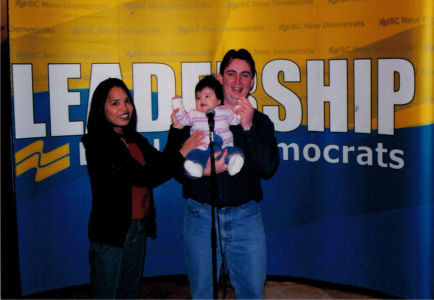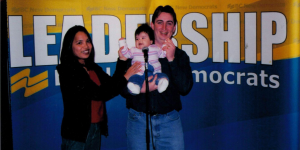Like many other children, I always looked forward to hearing a bedtime story from my parents before going to sleep. However, traditional stories of Goldilocks or Snow White are not the ones etched in my memory. Instead, at bedtime, my dad would sit beside my bed and tell me all about the injustices in the world - stories of how large corporations exploit workers, how women earn less than men, how war decimates societies, and countless more. Growing up with a union leader and social activist as a father, my earliest childhood photos are of me at conventions, strikes, and protests. In our home, we didn’t watch sports games. Instead, on election night, I sat in front of the TV, watching my dad celebrate elected seats as if they were touchdowns just scored. From an early age, I was more up-to-date on current events than most eight-year-olds I knew - a trait that sometimes earned me weird looks on the playground. This never bothered me though, because I was just as inspired by the idea of social change as the man who raised me. At the end of every story, after explaining the intricacies of injustice, he would tell me, “You will change this, Bryna. You will be the one to fix it.” And I believed him.
Twelve years later, I am halfway through a sociology degree, dreams unchanged. I carry a sense of responsibility and indebtment towards the society I live in, and I plan to spend my life devoted to pursuing it. While my father has involved himself in the realm of labour unions, my aspirations for social change lie in non-profit organizations. A core strength of mine has always been a natural inclination to leadership, as spending years training as an actor and musician has made me extremely comfortable in front of a crowd. Thus, my vocational ideal would be to invest my energy into a cause and non-profit organization that I am truly passionate about, and eventually work my way to executive director or other similar leadership role. I dream of being in a position where I have the resources and capability to execute real, tangible change. While I hypothesize that it may take me another twelve years to find the exact organization and cause that is best suited to me, I am confident that my studies in sociology and my drive to make a difference will push me to where I am meant to be.
The reaction I often receive when explaining my altruistic dreams to others is one of concern. I have received questions about how I plan to afford my first home or how I will deal with stress and burnout. To answer these, it is necessary to first define what a non-profit organization is and to conceptualize what my life might look like working for one. Simply put, a non-profit is an organization that operates for a social mission rather than to make money (Akingbola, Rogers, & Intindola, 2022). However, this definition is rather general and requires specification. I take a personal interest in organizations that focus on humanitarian work, and larger initiatives that aim to create change on a community-wide or even national level. I look to organizations like Salal Sexual Violence Support Centre, the largest sexual assault centre in BC, and Egale, Canada’s leading organization for LGBTQ+ people and issues, as examples of the non-profit work that I find inspiring. These organizations stand out to me because of their connection to causes I am passionate about and their wide reach in communities I am a part of. In Canada, there are over 1.6 million people employed in the nonprofit sector, with over 80% of these being women (Kosny & MacEachen, 2010). The demographic is overwhelmingly female-dominated, which correlates with the high amount of emotional labour often required for roles within this sector.
Rather than attempting to capture the entire world of non-profits, for the purpose of this paper, I will draw upon Amnesty International as an example of a non-profit organization I can see myself working at. Founded in 1961, Amnesty International is a human rights organization that fights for human rights around the world and frees prisoners of conscience (Amnesty International, 2024). There are many different roles in Amnesty’s many offices, from the leadership positions in the International Secretariat to support roles like administration assistants. Each works with a different sector, like fundraising or governance, to contribute to Amnesty’s overall goals.
Despite my drive to pursue this line of work, there are some crucial considerations to take into account. Evidence of mistreatment and burnout are present in many established non-profit organizations, with Amnesty International being no exception. In 2021, an internal review at Amnesty’s international secretariat was published highlighting instances of racism towards ethnic minority staff. Eight employees from Amnesty International UK spoke out about their experiences of racial discrimination, claiming in a statement that the leadership “knowingly upheld racism and actively harmed staff from ethnic minority backgrounds” (Parveen, 2021). These workers called out Amnesty for having a culture of white privilege, specifically referencing a “lack of awareness or sensitivity to religious practices resulting in problematic comments and behaviour” (Parveen, 2021). Furthermore, a 2019 report on Amnesty Staff Wellbeing brought up upsetting concerns surrounding a toxic workplace culture (Avula, Mckay, & Galland, 2019). It cited a severe lack of trust in senior management, who reportedly used bullying and public humiliation in the workplace (McVeigh, 2019). These are serious and troubling findings, and it is evident that despite fighting for equality and justice, humanitarian organizations are not exempt from systemic issues and internal challenges.
The concern of bullying and toxicity from management is not the only contributing factor to the difficulties of working at Amnesty International, as the report also found that ‘martyrdom culture’, was a significant issue. This occurs when staff sacrifice their personal well-being by taking on excessive workloads (McVeigh, 2019). The dedication and commitment of those working in human rights is commendable, but often a slippery slope leading to employee overload and burnout. This challenge is inherent to many humanitarian organizations where the urgency and gravity of the work often can take a heavy toll on the well-being of employees. The combination of a martyrdom culture, white privilege, and bullying from management creates a detrimentally harmful working environment that is unexpected for an organization that values human rights so highly. In light of this, I believe it is necessary to tread carefully when choosing which organization I choose to embed myself in, as well as be vigilantly aware of the possibility of potential challenges that may arise in these environments.
Despite what my eight-year-old self might think, I am aware that I will not be the person to single-handedly fix every societal issue. Although I set high expectations for myself, it is still crucial for me to confront and rationalize the possibility that I may not reach my career goals. Humanitarian work is extremely demanding, and there is a chance that I discover that the culture, workload, or remuneration of a non-profit does not fit my lifestyle. In such a scenario, my minor in psychology and experience working with children could instead push me to explore opportunities in teaching or counselling. I remain confident that even if it is not in humanitarian work, I will find a career that resonates with my drive for positive change. I know this because despite all the challenges and doubts, within me I still feel the presence of a child who was told, every single night, that she will one day make this world better. And to this day, I still believe it.

References
Akingbola, Kunle, Sean Edmund Rogers, and Melissa Intindola. 2023. “Nonprofit Organizations: The Land of Engagement.” Pp. 37–75 in Employee Engagement in Nonprofit Organizations. Palgrave Macmillan Cham.
Amnesty Careers. 2024. “Amnesty International Canadian Section English Speaking Careers Page.” Amnesty International Canada Job Board - Annual Giving Associate. Retrieved March 21, 2024 (https://amnesty.applytojobs.ca/fundraising/28982).
Amnesty International. 2023. “Who We Are.” Amnesty International Canada. Retrieved March 21, 2024 (https://amnesty.ca/who-we-are/#:~:text=Amnesty%20International%20is%20a%20global,protect%20and%20promote%20human%20rights.).
Avula, Kavita, Lisa McKay, & Sebastien Galland. 2019. Amnesty International Staff Wellbeing Review. Washington, DC: The Konterra Group.
Kosny, Agnieszka and Ellen MacEachen. 2010. “Gendered, Invisible Work in Non‐profit Social Service Organizations: Implications for Worker Health and Safety.” Gender, Work & Organization 17(4):359–80.
McVeigh, Karen. 2019. “Amnesty International Has Toxic Working Culture, Report Finds.” The Guardian. Retrieved March 21, 2024 (https://www.theguardian.com/world/2019/feb/06/amnesty-international-has-toxic-working-culture-report-finds).
Parveen, Nazia. 2021. “Amnesty International Has Culture of White Privilege, Report Finds.” The Guardian. Retrieved March 21, 2024 (https://www.theguardian.com/world/2021/apr/20/amnesty-international-has-culture-of-white-privilege-report-finds).
